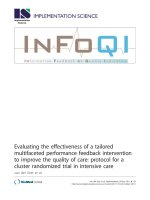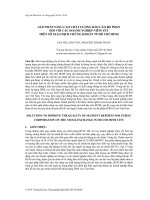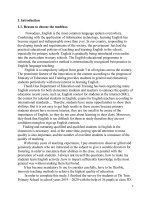skkn cấp tỉnh improve the quality of learning english for 10 graders by organizing games in teaching grammar
Bạn đang xem bản rút gọn của tài liệu. Xem và tải ngay bản đầy đủ của tài liệu tại đây (547.99 KB, 22 trang )
<span class="text_page_counter">Trang 1</span><div class="page_container" data-page="1">
<b>PART I: INTRODUCTION1.1.Rationale</b>
Grammar is an important and indispensable category in teaching andlearning any language. To teach grammar, teachers can use a variety oftechniques. However, it is undeniable that most students find it difficult toremember a grammar item or apply it in communication. If teachers wantstudents to remember a new piece of grammar, it needs to be learned and applieddirectly in context, practice and then corrected so that students don't forget.Therefore, teachers must use a variety of techniques to present and practice newgrammar. In fact, games are often used as short warm-up activities or when thereis little time left at the end of a lesson. As observed, a game should not be seen asa side activity that fills up those times when the classroom has nothing better todo. Games should be the focus of foreign language teaching. Mr. Richardsuggests that games should be used at all stages of English lessons, as long asthey are chosen appropriately and carefully.
Many factors need to be considered when discussing how to use games inlanguage teaching, one of which is relevance. Teachers should be very careful inchoosing games if they want to benefit the learning process. If the games are toyield the desired results, they should be parallel to the level or age of the student,or the materials to be introduced or practiced. Not all games are appropriate forall students regardless of age. Different age groups require different themes,materials, and gameplay. For example, students benefit from games that requiremoving around, mimicking patterns, group competition, and the like. Besides,Structured games intended to practice or reinforce certain grammatical aspects ofthe language must be related to the student's prior knowledge and abilities. Thegame becomes difficult and challenging when the given task or topic isinappropriate or out of the student's experience.
The game also helps learners remember grammar knowledge in a fun andentertaining way. All language researchers agree that even if grammar games arenoisy and entertaining, they are still worth considering for implementation in theclassroom because of their motivating nature. , promotes communication andcreates fluency for language learners.
There are many benefits of using games in grammar. First, games canreduce anxiety, thus making input more likely. Second, games are highlymotivating and entertaining, and they can give shy students more opportunities toexpress their opinions and feelings. Furthermore, they allow learners to gain anew experience of a foreign language that is not always possible in typical lessongames. Last but not least, games add diversion to regular classroom activities, and
</div><span class="text_page_counter">Trang 2</span><div class="page_container" data-page="2">help students familiarize themselves with new knowledge in a relaxed, easygoingatmosphere.
After considering all the benefits of the game, I decided to do this research on
<i><b>“Improve the quality of learning english for 10 graders by organizing games inteaching grammar” in the hope that it can improve and even change the usual</b></i>
teaching method of most English subjects. From there, teachers and students aremotivated to memorize and apply language in a specific communication contexteffectively.
Identifying Specific Grammar Challenges: To identify the specificgrammar concepts or rules that 10th graders commonly struggle with intheir English learning process.
Exploring Educational Games: To explore various educational games orinteractive activities that can be used to teach grammar conceptseffectively to 10th graders.
Designing Game-Based Lesson Plans: To develop detailed lesson plansthat incorporate the selected games or activities to teach specific grammarconcepts in an engaging and interactive manner.
Implementing Game-Based Approach: To implement the game-basedlesson plans in actual classroom settings and observe how the 10thgraders respond to this approach.
Assessing Learning Outcomes: To measure the learning outcomes andimprovements in grammar comprehension and application among the10th graders after participating in the game-based lessons.
Comparing Results: To compare the learning outcomes of the studentswho participated in the game-based lessons with those who were taughtusing traditional methods.
By achieving these research objectives, the study aims to gather empiricalevidence and insights that can inform educators, curriculum developers, andpolicymakers on the benefits of integrating game-based approaches into theteaching of grammar for 10th graders.
</div><span class="text_page_counter">Trang 3</span><div class="page_container" data-page="3"><b>1.3. Research scope</b>
The research scope for the study focused on improving the quality of learningEnglish grammar for 10th graders using game-based teaching approachesspecifically within the context of the "Grammar lessons in Global textbookgrade 10." This scope defines the boundaries and parameters within which theresearch was conducted.
Key aspects of the research scope include:
<b>Grade Level: The study exclusively targeted 10th-grade students, who</b>
are typically around 15 years old, and aimed to enhance their understanding andapplication of English grammar concepts.
<b>Textbook: The research specifically revolved around the grammar</b>
lessons contained in the "Global Success textbook grade 10." This means thatthe selected grammar concepts, examples, and exercises from this textbookserved as the basis for designing game-based activities.
<b>Grammar Concepts: The study focused on identifying and addressing</b>
specific grammar concepts within the chosen textbook. These could includetopics such as verb tenses, sentence structure, parts of speech, punctuation, andmore.
<b>Game-Based Approach: The primary teaching approach under</b>
investigation was game-based learning. The study aimed to incorporate varioustypes of educational games, interactive activities, and gamified exercises toteach the selected grammar concepts.
<b>Learning Outcomes: The research intended to assess the effectiveness of</b>
the game-based approach in terms of improving grammar comprehension,application, and overall English language proficiency among the 10th graders. <b>Comparison with Traditional Methods: While the primary focus was</b>
on game-based teaching, the study might have included a comparative analysisbetween the outcomes of using game-based methods and traditional teachingmethods for grammar instruction.
<b>Classroom Context: The research was likely conducted in real classroom</b>
settings, involving actual 10th-grade students and their English languageteachers. This allowed for the observation of student engagement, interaction,and responses to the game-based lessons.
Overall, the research scope provided a clear framework for investigating theeffectiveness of game-based approaches in improving grammar learningoutcomes among 10th graders using the "Grammar lessons in Global Successtextbook grade 10" as the foundation for instructional content.
</div><span class="text_page_counter">Trang 4</span><div class="page_container" data-page="4"><b>1.4. Research Methodology</b>
The research methodology outlines the systematic approach and methods used toconduct the study on improving the quality of learning English grammar for 10thgraders using game-based teaching approaches within the context of the"Grammar lessons in Global Success textbook grade 10." Here is a generaloverview of the potential research methodology that could have been employed:
<b>Research Design: The study could use a mixed-methods research design,</b>
combining both quantitative and qualitative methods to gain acomprehensive understanding of the effectiveness of the game-basedapproach.
<b>Sampling: Select a representative sample of 10th-grade students and their</b>
English language teachers from different schools to ensure diversity andgeneralizability of the findings.
<b>Data Collection:</b>
<b>o Pre-assessment: Administer a pre-assessment test to measure</b>
students' baseline grammar comprehension before the intervention.
<b>o Game-Based Lessons: Implement game-based lessons designed</b>
around specific grammar concepts from the "textbook grade 10."
<b>o Observations: Observe classroom interactions, student engagement,</b>
and teacher facilitation during the game-based lessons.
<b>o Post-assessment: Administer a post-assessment test to measure</b>
improvements in grammar comprehension after the game-basedintervention.
<b>o Student Surveys: Collect surveys from students to gather feedback</b>
on their perceptions of the game-based approach, engagement level,and perceived learning outcomes.
<b>Findings and Discussion: Present and discuss the research findings,</b>
including quantitative results indicating improvements in grammarcomprehension and qualitative insights on engagement, motivation, andchallenges.
<b>Implications and Recommendations: Based on the findings, provide</b>
implications for educators, curriculum developers, and policymakers on thepotential benefits of incorporating game-based approaches into grammarinstruction. Offer recommendations for improving the implementation ofgame-based methods.
<b>Conclusion: Summarize the study's key findings, contributions to the field,</b>
and potential future research directions.
The specific details of the research methodology would depend on the researchteam's preferences, available resources, and the context of the educationalinstitution. The goal is to use a well-structured and comprehensive methodology
</div><span class="text_page_counter">Trang 5</span><div class="page_container" data-page="5">that produces reliable and valid results while contributing valuable insights to thefield of education.
<b>PART II: RESEARCH CONTENTS2.1. Theoretical basis</b>
The use of games in teaching English has garnered significant attention fromeducational researchers and practitioners alike. Initially, traditional pedagogicalmethodologies emphasized direct instruction and rote learning. However, asPeregoy and Boyle (2013) assert, "Language is best learned when it is used formeaningful tasks in a supportive context" (p. 45). In this light, the introduction ofgames can provide such a context. Furthermore, Wright, Betteridge, and Buckby(2006) pointed out that games are highly motivational and can create a livelylearning atmosphere, thereby fostering engagement and facilitating retention.Moreover, not only do games break the monotony of the usual classroom routine,but they also encourage learners to interact and communicate, which, accordingto Richards and Rodgers (2001), is vital for language acquisition. Given theseperspectives, there is a growing consensus that integrating games into grammarlessons can significantly enhance the learning experience for 10th graders,making the subject matter more accessible and engaging. Such an approach canpotentially bridge the gap between theoretical grammar knowledge and itspractical application in real-life communication.
<b>2.2. Practical basis before applying the measure2.2.1. Advantages:</b>
The current situation of teaching English grammar at Trieu Son 1 uppersecondary school brings forth several advantages. Firstly, the school is renownedas a trailblazing institution within the education sector of , celebrated for itsdedication to learning. Furthermore, the school's leaders exhibit profoundexpertise, enthusiasm, and a proactive approach in creating a conduciveenvironment for teachers to fulfill their duties. The teaching faculty comprisesenergetic and highly qualified educators who exceed the standard requirements.The school's infrastructure is well-equipped, aligning with the established criteria.Most English teachers at the school demonstrate remarkable engagement,proficiency, and vitality. This enables them to consistently enhance their teachingtechniques. Their commitment to the profession is palpable, as they investsubstantial time in teaching with the aspiration that their knowledge willcontribute to the students' future accomplishments.
<b>2.2.2. Disadvantages:</b>
</div><span class="text_page_counter">Trang 6</span><div class="page_container" data-page="6">Conversely, despite these merits, various challenges persist. In specifichouseholds, parental focus is primarily on economic matters, with limited genuineconcern for their children's education or encouragement to study. These parentstend to rely solely on teachers for educational guidance. Additionally, teachers'extensive teaching schedules curtail their time for research. This situationhampers the development of innovative teaching methods. Moreover, thestudents' independent learning skills remain underdeveloped, leading to low self-confidence and passivity in group activities.
For students, particularly those at Trieu Son 1 upper secondary school, learningEnglish proves to be an arduous task. Being first-generation learners, they lackguidance from parents and other sources. Although they study English,constructing even a single grammatically correct sentence becomes a challenge.This deficiency can be attributed to the exam-centric approach they follow. Thecurrent testing system emphasizes rote memorization rather than assessinganalytical and creative capacities. Consequently, students memorize material forexams, reproduce it during assessments, and swiftly forget it thereafter.
Furthermore, students in my areas fail to recognize English as a vital means ofglobal communication. Their reluctance to speak English stems from a weakgrasp of the language and limited self-assurance. A significant contributor to thisissue is the Grammar-Translation Method employed in teaching. This method,used primarily for young learners, relies heavily on explanations in the nativelanguage to facilitate comprehension of English. Unfortunately, this techniquefosters dependency on the mother tongue, undermining the acquisition of Englishlanguage skills. Both teachers and students become preoccupied with the nativelanguage, eroding the foreign language classroom atmosphere. As a result,students derive limited benefits from this approach, hindering their progress inEnglish language proficiency.
<b>2.3. Measures taken to solve the problem</b>
<b>2.3.1. Measure 1: Game Name: "Action Snap!"</b>
<b>Objective: To differentiate between the present simple tense and the present</b>
continuous tense in unit 1.
<b>Materials Needed:</b>
Two sets of cards.
<small></small> One set with verbs in their base form (e.g., "run", "eat", "sing").
<small></small> The second set with illustrations or photos showing people performing various actions.
A timer.
<b>Duration: 25 minutes</b>
</div><span class="text_page_counter">Trang 7</span><div class="page_container" data-page="7"> <b>Setup (5 minutes):</b>
<small></small> Divide the students into pairs or small groups.
<small></small> Give each group two sets of shuffled cards: one with verbs and one with illustrations.
<small></small> Explain the difference between present simple (used for regular or habitual actions) and present continuous (used for actions that are happening right now).
<b>Playing the Game (15 minutes):</b>
<small></small> Lay out the illustration cards face up in the middle.
<small></small> Students take turns drawing a verb card.
<small></small> The student must form a sentence using the verb in either the presentsimple or present continuous form, depending on the illustration theymatch it with.
<small></small> For example, if the verb card says "run" and they match it withan illustration of someone running, they might say, "He is running." (present continuous).
<small></small> If they match it with a static image, e.g., a pair of shoes, they might say, "I run every morning." (present simple).
<small></small> The other players in the group must agree if the sentence is correct. If it's correct, the player keeps the pair of cards. If not, the cards return to the center.
<small></small> The aim is to form as many correct sentences as possible in the giventime.
<b>Review and Feedback (5 minutes):</b>
<small></small> After 15 minutes, or once all the cards have been matched, the game ends.
<small></small> Groups count how many pairs of cards they have. The group with themost pairs wins.
<small></small> As a class, discuss some of the sentences formed and correct any common mistakes. Highlight the differences between the two tenses and when each should be used.
This game allows students to actively engage with the present simple and presentcontinuous tenses, reinforcing their understanding of when to use each tense. Thecompetitive element also makes it fun and encourages participation.
</div><span class="text_page_counter">Trang 8</span><div class="page_container" data-page="8"><b>2.3.2. Measure 2: Game Name: "Passive Voice Mystery"</b>
<b>Objective: To practice forming and identifying sentences in the passive</b>
<b>Setup (5 minutes):</b>
<small></small> Prepare index cards with written actions in the active voice, e.g.,"The chef cooked the meal", "The artist painted the portrait", "Theteacher taught the lesson".
<small></small> Shuffle the cards and place them in a container or hat.
<small></small> Set the scene for a mystery: "At the Passive Voice Mansion, actionsare done by unknown subjects! We must find out what happened!" <b>Playing the Game (15 minutes):</b>
<small></small> Divide the students into pairs or small groups.
<small></small> One student from each group comes forward and draws a card fromthe container.
<small></small> Without showing it to anyone, the student reads the active voicesentence and then creates a sentence using the passive voice. For
</div><span class="text_page_counter">Trang 9</span><div class="page_container" data-page="9">example, if the card says, "The chef cooked the meal", the studentmight say, "The meal was cooked."
<small></small> The other students in the group must then guess the original activevoice sentence.
<small></small> For an added challenge and to create a more tangible mysterysetting: Before drawing a card, use props or pictures to set a scene.For the above example, you could set out a plate of food. Aftersaying "The meal was cooked", students also have to guess who (orwhat) was responsible in the original sentence.
<small></small> Rotate turns among group members. <b>Review and Feedback (5 minutes):</b>
<small></small> After all the cards have been used or once the 15 minutes are up,gather the students.
<small></small> Review some of the sentences formed and clarify anymisconceptions. Discuss the structure of the passive voice andhighlight its components (e.g., "be" verb + past participle).
<small></small> Ask students about situations in real life where the passive voicemight be preferred or commonly used (e.g., formal writing, scientificreports, when the "doer" of the action is unknown or not important).This game encourages students to think on their feet and reinforces thestructure of the passive voice. The element of mystery makes it fun and addscontext to the use of the passive voice.
</div><span class="text_page_counter">Trang 10</span><div class="page_container" data-page="10"><b>2.3.3. Measure 3: Game Name: "Gerund vs. Infinitive Challenge"</b>
<b>Objective: To practice identifying and using gerunds and to-infinitives in</b>
unit 3 correctly in sentences.
<small></small> Divide the students into pairs or small groups.
<small></small> One student comes forward and draws one card from each container.
<small></small> Using the structure on the board, the student creates a sentence,deciding whether to use the gerund or to-infinitive form of theactivity. For instance, if the drawn cards are "like" (from the Gerundcontainer) and "dance" (from the Infinitive container), the studentcan form either "I like dancing" or "I like to dance."
<small></small> The other students then discuss if both forms are correct, or if one ispreferred over the other based on the verb drawn.
<small></small> Once consensus is reached, the instructor provides feedback,clarifying or confirming the correct usage.
<small></small> Rotate turns among group members. <b>Review and Feedback (5 minutes):</b>
<small></small> After all the cards have been used or once the 15 minutes are up,regroup the students.
<small></small> Discuss common verbs that are typically followed by gerunds, thosefollowed by to-infinitives, and those that can be followed by either.
<small></small> Address any misconceptions and provide examples to clarify therules.
</div><span class="text_page_counter">Trang 11</span><div class="page_container" data-page="11">This interactive game provides students with hands-on practice, forcingthem to critically think about the correct form to use. The group discussionencourages collaboration and allows for peer learning, making the understandingof gerunds and to-infinitives more engaging and robust.
<b>2.3.4. Measure 4: Game Name: "Time Travel Tales"</b>
<b>Objective: To practice using the simple past and past continuous tenses in</b>
unit 4 correctly within a narrative context.
<small></small> Shuffle the cards separately and place them in their respectivecontainers.
<small></small> On the board, write the structure for guidance: "[BackgroundActivity], when [Action]."
</div>








